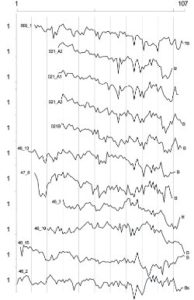 A significant breakthrough in the dating of Iron Age settlement in Scotland came at the crannog of Dorman’s Island, when the first prehistoric dendro date was obtained from split oak logs used as flooring on the island. This showed that that crannog was occupied between 153 and 121 BC and again in the sub-Roman period, but most crucially demonstrating that Galloway crannogs could be linked to Irish and northern English dendrochronological sequences.
A significant breakthrough in the dating of Iron Age settlement in Scotland came at the crannog of Dorman’s Island, when the first prehistoric dendro date was obtained from split oak logs used as flooring on the island. This showed that that crannog was occupied between 153 and 121 BC and again in the sub-Roman period, but most crucially demonstrating that Galloway crannogs could be linked to Irish and northern English dendrochronological sequences.
From this basis, further samples from Cults Loch and Black Loch of Myrton have refined the dating of those sites to to within a few years in the mid 5th century BC. As more dendro dates are obtained, patterns are emerging, and dates seem to cluster around similar horizons. It is possible that crannog building occurred sporadically through time, and that the impression of continuous building over hundreds of years given by radiocarbon dates is misleading.
These themes are explored in a paper by Anne Crone, published in Lake Dwellings After Munro: read the volume online for free, here.
